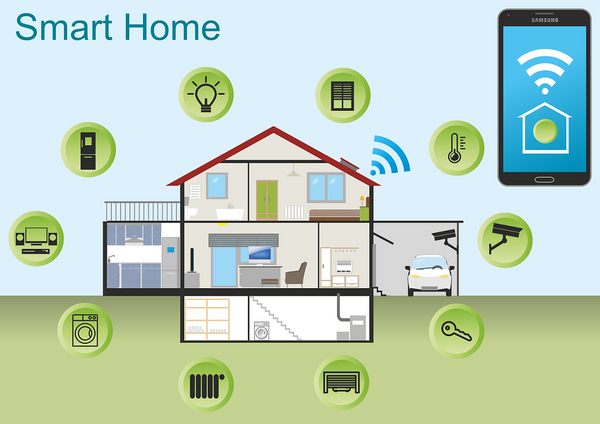Is your home smart? Start working on your network security

We are only a button away from controlling our homes or, more correctly, just a fingerprint or voice control away. Smart water valves and thermostats, home controllers, fancy door locks, switches, plugs, light bulbs, alarms and surveillance systems, baby monitors, toys, fridges and even pet feeders are among the many devices that communicate with each other via internet.
This communication, though, is not always encrypted, which makes room for DDoS and man-in-the-middle attacks.
At the top of the list for manufacturers, consumer smart devices make up a fast growing sector. Some 5.2 billion units will be in use in 2017, according to Gartner analysts, accounting for 63 percent of the total number of devices.
“Aside from automotive systems, the applications that will be most in use by consumers will be smart TVs and digital set-top boxes, while smart electric meters and commercial security cameras will be most in use by businesses,” said Peter Middleton, research director at Gartner.
The smart home is real – it”s no longer an image of the future. But how many users are aware their homes fit the pattern? Many are confused as to whether they live in a smart home and disoriented in general when talking about smart homes and the internet of things, found a recent Bitdefender study.
“On average, a household from the United States carries 13 smart devices or accessories,” the study says. “There are 12 in the UK and Australia, and 10 in France, Romania and Germany.”
This is fantastic news, except users are a bit unsure when questioned about the smart home concept. Globally speaking, users in the US and France are more up to date on the smart home concept. Still, only 30% of US smart home residents and 20% of those in France are aware they live in a smart home. Those in the UK, Romania and Australia are even less aware of their connected ecosystem, the study found. The most prevalent devices were smartphones, computers and tablets, smart TVs and wireless gaming consoles.
We want our coffeemaker to know when we wake up so it can have coffee ready, the pet feeder to feed for our pets while we are on vacation or for the egg holder to let us know when they are expired so we buy a new carton. Such an abundance of connected devices, however, often comes with lax security.
Why don”t manufacturers make IoT security a top priority instead of rushing to launch a product? Most likely because users don”t ask for it, since they don”t even know they are living in a smart home. The worst part is that they”re not looking at the bigger picture – hackers are not necessarily interested in them personally, but in what they can do with the exploited infrastructure.
“More people need to realize that attackers are not targeting only the device,” says Alexandru Balan, Chief Security Researcher at Bitdefender. “They look for an easy entry point into your home network, to see how they can break into other connected machines and steal any unsecured information passing through the network.”
Security is a top priority for Australians and Romanians, who are mostly concerned about hackers stealing their data through unsecured smart devices and then leaking it online. Other concerns at the top of the list are losing control over their devices that hackers will exploit for illicit activities such as large DDoS attacks and surveillance.
So how can users make their smart homes more secure? First of all, enable network encryption and always update device firmware. Software updates are extremely important so they should be performed regularly, yet users tend to neglect this aspect. As many as 42 percent of US users have never performed firmware or default software package updates. Romanians (51 percent), UK and Australian users (38 percent), Germans (27 percent) and French (34 percent) are just as negligent with their security, blaming it on lack of tech knowledge and time, says Bitdefender.
Besides regular updates, always use strong, unique passwords for all devices and accounts accessed through the infrastructure. Never reuse passwords! Pay close attention to the apps to make sure they are legitimate, pause the in-built camera of the devices when not in use, never click on suspicious links appearing on the smart TV and use a professional home security solution to prevent attacks and malware infection.
“Although manufacturers are not always quick to push security updates for known vulnerabilities, users shouldn”t postpone installing them, once available,” Balan says. “Cybercriminals often infiltrate home and corporate networks through outdated software – so, whether it is a laptop or a smart device, security updates should be installed with the same diligence by users. Administering intelligent devices within the household is a full-time job that requires energy and a new set of skills that need to be learned.”
tags
Author
After having addressed topics such as NFC, startups, and tech innovation, she has now shifted focus to internet security, with a keen interest in smart homes and IoT threats.
View all postsRight now Top posts
How to Protect Your WhatsApp from Hackers and Scammers – 8 Key Settings and Best Practices
April 03, 2025
Outpacing Cyberthreats: Bitdefender Together with Scuderia Ferrari HP in 2025
March 12, 2025
Streamjacking Scams On YouTube Leverage CS2 Pro Player Championships to Defraud Gamers
February 20, 2025
How to Identify and Protect Yourself from Gaming Laptop Scams
February 11, 2025
FOLLOW US ON SOCIAL MEDIA
You might also like
Bookmarks








